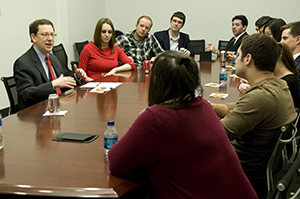The Deans Collection
The Law School’s D’Angelo Law Library has created a new digital collection to showcase the history, achievements, and legacies of the deans of the Law School. Since its founding in 1902, the Law School has had fourteen deans. This collection, curated initially by Mariana Brandman, the 2020-2022 Hanna Holborn Gray Fellow, aims to tell the story of the Law School through the deans who have shaped its history.
At the turn of the twentieth century, University of Chicago President William R. Harper set out to create a premier law school in the West.
1902-1904
Joseph Henry Beale
At the request of President Harper, Beale took a two-year leave from Harvard Law to help build the Law School from the ground up. Its first home was Stuart Hall.
1904-1928
James Parker Hall
Hall is the longest-serving dean in the history of the Law School. He held high ideals for the Law School and maintained rigorous standards to ensure its excellence. Hall felt strongly that legal education was a matter for graduate study, a model that UChicago and its Law School pioneered throughout the twentieth century.
1928-1939
Harry A. Bigelow
Bigelow expanded the curriculum to include subjects not traditionally taught in American law schools, such as economics, psychology, history, political science, and statistics. This placed UChicago on the vanguard of American legal education. Bigelow also oversaw the founding of The University of Chicago Law Review.
1939-1950
Wilber G. Katz
Katz’s years as dean spanned the prewar, wartime, and postwar years of 1939-1950. Having led the committee that birthed the curricular innovations from Bigelow’s time, Katz continued the Law School down the same trajectory. He also served as the unofficial mentor to The University of Chicago Law Review.
1950-1962
Edward H. Levi
Levi oversaw the marked academic and physical growth of the Law School. He established a development campaign, which, along with grant funding from the Ford Foundation, led to Levi’s most tangible contribution: the Laird Bell Law Quadrangle.
1963-1975
Phil C. Neal
Neal made his biggest mark on the Law School through his influential faculty hires, three of whom would serve as the next three deans. Programming also flourished during his time; he helped the community utilize the potential of the new Laird Bell Quadrangle.
1975-1979
Norval Morris
Morris bolstered the strength of the Law School’s faculty and initiated the capital campaign to revitalize the Law School’s library. He kicked off the fundraising effort that would result in the dedication of the D’Angelo Law Library in 1987.
1979-1987
Gerhard Casper
Casper oversaw a massive campaign that allowed for new endowed professorships and financial aid, as well the expansion of the library’s building by 45 feet to the south. The library’s bookstack capacity doubled and the Louis H. Silver Special Collections Room’s capacity for rare books quadrupled.
1987-1994
Geoffrey R. Stone
Stone established the Law School’s famous Work-in-Progress workshop, providing a means for faculty to present papers to their colleagues every week in lively discussions. He sought to foster a community spirit among students by incorporating their input on faculty committees, holding quarterly town halls, and fostering the creation of new academic and social organizations.
1994-1999
Douglas G. Baird
Baird oversaw an artistic addition to the Law School environs in 1994. Four paintings, known as “The Law School Series,” by Chicago artist Judy Ledgerwood, were hung in the Green Lounge that autumn. He also facilitated the establishment of the Institute for Justice Clinic on Entrepreneurship.
1999-2001
Daniel R. Fischel
Fischel sought to support a wide range of career paths for Law School students. In particular, he encouraged entrepreneurship-related initiatives designed to prepare students for contemporary challenges in the legal field, such as globalization and the digital revolution.
2001-2009
Saul Levmore
Levmore’s tenure saw significant changes at the Law School: more modern facilities, including renovated classrooms, impressive faculty hires, innovative curricular expansions, and an increase in clinical opportunities for students.
2010-2015
Michael H. Schill
A central focus of Schill’s deanship was to provide opportunities for students to develop leadership skills. He oversaw the institution of the Keystone Professionalism and Leadership Program, the Doctoroff Business Leadership Program, and the Kapnick Leadership Development Initiative.
2015-Present
Thomas J. Miles
Miles, the Clifton R. Musser Professor of Law and Economics, had been on the faculty for ten years before becoming dean. He deepened the Law School’s distinctive commitment to scholarship and learning through new centers and clinics, curricular innovations (including in the 1L year and in business-law), and the recruitment of outstanding faculty.



























